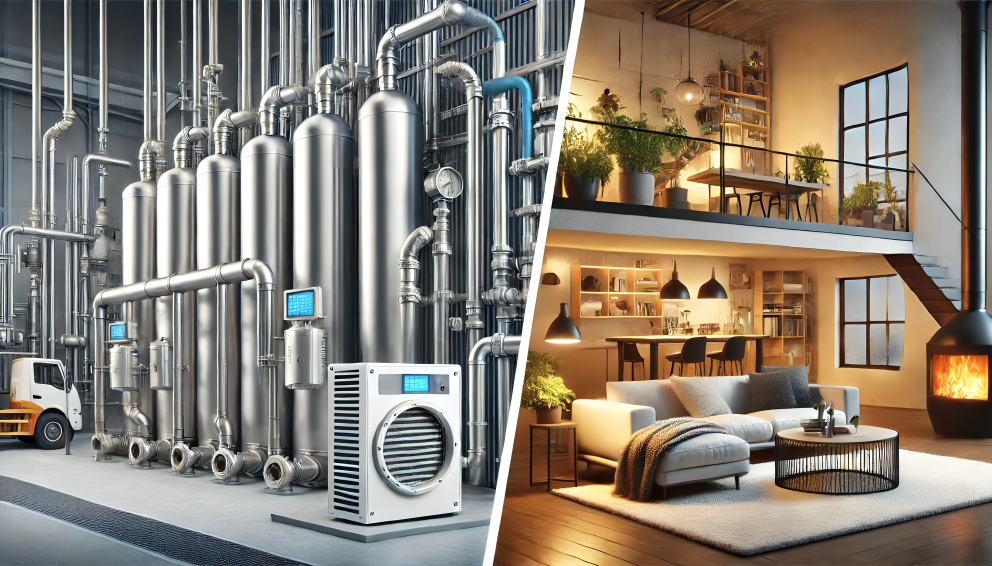Heat exchangers are vital components in many heating and cooling systems, facilitating the transfer of heat between two or more fluids. Their applications range from industrial processes to residential heating and cooling systems. Understanding the different types of heat exchangers and how to choose the right one for your specific needs can help improve energy efficiency, reduce costs, and enhance overall system performance.
This guide explores the various options available, key factors to consider, and tips for selecting the best heat exchanger for your requirements.
Understanding Heat Exchangers
A heat exchanger is a device that transfers heat between two or more fluids without mixing them. The basic principle relies on the second law of thermodynamics, which states that heat naturally flows from hot to cold. By utilizing this principle, heat exchangers enable efficient energy transfer in systems such as HVAC, refrigeration, and industrial processes.
Types of Heat Exchangers
Shell and Tube Heat Exchangers:
These are among the most common types used in industrial applications. They consist of a series of tubes, with one fluid flowing through the tubes and another fluid flowing around them within a shell. This design allows for high heat transfer efficiency and is suitable for high-pressure applications.
Plate Heat Exchangers:
Made up of multiple thin plates, these heat exchangers provide a large surface area for heat transfer while maintaining a compact size. They are commonly used in both industrial and residential applications, especially in HVAC systems, due to their efficiency and ease of cleaning.
Air-Cooled Heat Exchangers:
Utilizing air as the cooling medium, these heat exchangers are ideal for outdoor applications where water is scarce. They are often used in refrigeration and air conditioning systems.
Double-Pipe Heat Exchangers:
These consist of two concentric pipes, with one fluid flowing through the inner pipe and the other in the annular space between the two pipes. They are simple in design and commonly used for small-scale applications.
Finned Tube Heat Exchangers:
These exchangers have fins attached to the tubes to increase the surface area for heat transfer. They are often used in heating and cooling applications where air or other gases are involved.
Key Factors to Consider
When selecting a heat exchanger, several factors must be taken into account to ensure optimal performance:
1. Application Requirements:
The intended application of the heat exchanger is a key factor in the selection process. For industrial settings, heat exchangers must be capable of withstanding high pressures and temperatures.
In contrast, residential applications often emphasize energy efficiency and a compact design. Incorporating welded bellows can further enhance these units by providing superior sealing and flexibility, ensuring optimal performance in both high-pressure and energy-efficient scenarios.
2. Material Compatibility:
Different fluids may require specific materials to prevent corrosion and ensure longevity. For instance, stainless steel or titanium may be suitable for corrosive fluids, while copper is often used for its excellent thermal conductivity in residential applications.
3. Heat Transfer Efficiency:
The efficiency of a heat exchanger can significantly impact energy costs. When evaluating options, consider the overall heat transfer coefficient (U-value) and the effectiveness of the exchanger.
4. Size and Space Constraints:
Space availability is crucial, especially in residential applications. A compact design may be necessary to fit within existing systems or to meet aesthetic requirements.
5. Maintenance and Cleaning:
Some heat exchangers are easier to clean and maintain than others. Consider the frequency of maintenance required and whether the design allows for easy access.
6. Cost:
While initial costs are important, consider the long-term operating costs, including energy efficiency and maintenance expenses. Sometimes, investing in a higher-quality heat exchanger can lead to savings over time.
Finding the Best Heat Exchanger
To find the best heat exchanger for your needs, follow these steps:
- Evaluate Your Needs: Determine the specific requirements for your application, including the type of fluids involved, temperature ranges, and pressure levels.
- Research Options: Investigate different types of heat exchangers that fit your criteria. Consider efficiency ratings, materials, and manufacturer reputation.
- Consult with Experts: If you’re unsure about which heat exchanger is best for your application, consult with HVAC professionals or engineers who specialize in heat transfer systems. They can provide valuable insights and recommendations.
- Read Reviews: Look for reviews and case studies that demonstrate the performance of specific heat exchangers in applications similar to yours.
- Request Quotes: Contact suppliers and manufacturers to request quotes and compare prices. Be sure to inquire about warranties and support services.
- Test and Monitor Performance: Once you’ve installed a heat exchanger, monitor its performance closely. Make adjustments as needed to optimize efficiency and ensure longevity.
In Conclusion
Whether you’re looking for a heat exchanger for industrial or residential purposes, understanding the various types available and the key factors to consider will help you make an informed decision.
By carefully evaluating your needs and consulting with experts, you can find the best heat exchanger that will enhance your system’s performance, improve energy efficiency, and provide reliable service for years to come. Investing time in selecting the right heat exchanger will ultimately pay off in the form of reduced costs and increased comfort in your home or facility.

